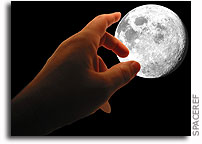Let’s Name the LCROSS Impact Crater After Walter Cronkite

Editor’s note: The other night I started to Twitter that I thought it would be a good idea that the crater LCROSS will form should be named in honor of veteran space journalist Walter Cronkite who died the other day. Others joined in and repeated that idea.
So what is the LCROSS_NASA team’s response? They dodge the issue: “Our team heard your requests. When it comes to naming craters, it is up to the IAU. NASA can explore possibility of petition to IAU to name.”
As you will recall during Apollo missions, crew members named craters and other features. And the Mars rover people name craters, rocks, pebbles, and all manner of things all the time. Do they ask the IAU for permission to do that? NO. Indeed, the names given to rocks at the Viking lander sites in 1976 by mission personel are still in use.
So c’mon guys. Use a little imagination – use crowd sourcing and involve the public – the same public who paid for your mission and who were well served by Mr. Cronkite for decades. LCROSS can certainly recommend a name and use their own name in the mean time. There is no legally binding reason to prohibit NASA from doing this – nothing IAU does has the force of law. Indeed, the IAU does not have any interest whatsoever in the view of the public anyway.
To virtually all who watched him, Walter Cronkite was always a face on a screen – one painted upon our eyes by photons. Imagine how many thousands – maybe millions – would now stop for a moment to watch as this crater was created in his name? How often can you stand in your backyard and see that? In so doing, Walter Cronkite can have one last stupendous effect on the world – from the Moon – through a blast of photons travelling one last time to our eyes.
Here is a short list of LCROSS target craters ( From NASA LCROSS) on the lunar south pole. Click on Image to enlarge. Impact is currently planned fo 4:30 a.m. PDT, October 9, 2009.:
|
LCROSS Candidate Impact Craters
|
|||||
|
Designation
|
Crater Name
|
Sun Mask
|
Eath Mask
|
Latitude
|
Longitude
|
| SP A | Faustini |
2.3
|
0.9
|
-87.2°
|
89°E
|
| SP B | Shoemaker |
3.5
|
-0.6
|
-88.5°
|
50°E
|
| SP C | Cabeus |
3.0
|
8.5
|
-85°
|
35.5°W
|
| SP CB | Cabeus B |
0.9
|
-0.5
|
-81.7°
|
54.5°W
|
| SP CC | none |
2.5
|
0.1
|
-83.5°
|
16°W
|
| SP D | Hawworth |
2.7
|
0.8
|
-87.4°
|
5°W
|
| SP F | none |
1.8
|
0.5
|
-82.3°
|
12°E
|
| SP G | none |
2.4
|
0.4
|
-84.3°
|
1°E
|
Sun Mask is the depth, in kilometers, of the crater below where the sun’s light does not penetrate. Earth mask is the depth of the crater below that is not visible from Earth. At various time of the year, the libration or wobble of the moon on its axis gives Earth obsevers the ability to look deeper into the permanenty shadowed craters on the south pole.
This list of candidate craters is based on current information about the age, depth and structure of the selected craters. Approximately 30 days before impact, the LCROSS science team will announce the selection of the final impact crater. The selection will take into account any additional information, especially from the Lunar Reconnaissance Orbiter, collected about the candidate craters.









